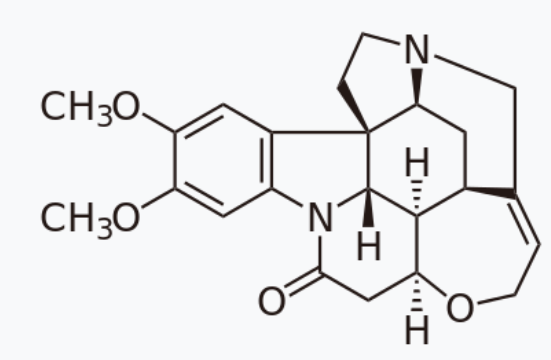Nux Vomica : Biological Sources,Morphological Features,Chemical Constituents, Medicinal Uses

NUX VOMICA
1. Biological sources :
• Nux vomica belongs to loganiaceae family.
• It is also known as poison nut, semen strychnos , kuchla and quaker buttons.
• The biological source of nux vomica is dried ripe seeds of Strychnos nux vomica.
• They also known as dog buttons ,vomit nut and crow fig.
• It contain not less than 1.2% strychnine.
2. Morphological features :
• It is a deciduous tree and medium sized tree.
• It have short, crooked, thick trunk and the wood is white and hard.
• Branches are irregular and covered with a smooth ash- coloured bark.
• Leaves are opposite ,short stalked.
• The shape of leaves is oval and smooth and shiny on both sides.
• The size of leaves is about 4 inches long and 3 inches broad.
• Flowers are small , funnel shape in small terminal cymes .
• The color of flowers are greenish-white.
• Fruit contain smooth hard rind or shell and ripe have orange color and have jelly like pulp.
• Fruit have five seeds covered with a soft woolly like substance which is white and horny internally.
• The shape of seed is flattened disks densely covered with closely appressed satiny hairs.
• The size of seed is 10-30 mm in diameter and 3-5 mm thick, radiating from the centre of the flattened sides which give a characteristic sheen to the seeds.
• Seeds contain dark grey horny endosperm in which the small embryo is embedded.
• It have no odour but a very bitter taste.
3. Chemical constituents :
• Alkaloids are the major chemical constituent of nux vomica.
• It contain 1.25% strychnine and 1.5% brucine.
• It contain glucoside loganin and about 3% fatty matter.
• It contain caffeotannic acid and trace of copper.
• It consist of 2.5-3.5 % bitter indole alkaloids.
• Strychnine is the major chemical constituent of nux vomica which is therapeutically active and toxic alkaloid which is located in the central portion of endosperm.
• The another major constituent of nux vomica is brucine which is chemically dimethoxystrychnine and it is less toxic which have very low physiological action.
• It is intensely bitter and used as a standard determining the bitter value, of many bitter drugs.
• The amount of brucine is more in the outer part.
• They have vomicine and pseudostrychnine which are minor alkaloids as chemical constituents.
• The other chemical constituents of nux vomica are chlorogenic acid or caffeotannic acid, which are present in the seed.
• Hemicelluloses is a reserved material found in the thick cell wall of endosperm.
• Hemicelluloses consist of mannan and galactan which on hydrolysis yield mannose and galactose.
4. Uses :
• It is used to increase appetite i.e. it stimulates peristalsis in chronic constipation due to atony of the bowel it is often combined with cascara and other laxatives with good effects.
• Strychnine is the major chemical constituent of nux vomica helps to increase the flow of gastric juice.
• The major constituent of nux vomica, strychnine has a stimulant action on spinal cord and reflex movements are better.
• It is used as a sex tonic and nervine.
• It is used to treat cardiac failure because smell, touch, hearing and vision are rendered more acute and improves pulse and rise blood pressure.
• The other chemical constituent of nux vomica is brucine which has less poisonous nature and used in pruritis.
• It is also used as a local anodyne in inflammations of the external ear.
• It is used to treat neurasthenia ,a diseased condition in which excessive fatigue occur in neurotic origin.
• It is a bitter stomachic, which strengthen stomach and promote its action.
5. Adulterants :
• The common adulterants of nux vomica are Strychnine potatorum and Strychnine nux blanda.
• Strychnine potatorum commonly known as clearing nut which do not contain alkaloids ,even in small amount and also it is not bitter.
6. MULTIPLE CHOICE QUESTIONS :
1. What is the botanical name of nux vomica?
(a) Brassica juncea
(b) Allium cepa
(c) Mirabilis jalapa
(d) Strychnos nux-vomica
2. The biological source of nux vomica is
(a) Leaves
(b) Roots
(c) Dried ripe seeds
(d) Bark
3. The shape of seeds of nux vomica is
(a) Oval
(b) Round
(c) Flattened disk
(d) Oblong
4. Match the following with respect to the chemical constituents of plants.
I. Nux vomica A. Strychnine
II. Ergot B. Feruloylhistamine
III. Ephedra C. Ergometrine
IV. Vinca D. Vincristine
(a) I-B,II-C,III-D,IV-A
(b) I-D,II-B,III-C,IV-A
(c) I-A,II-C,III-B,IV-D
(d) I-C,II-D,III-A,IV-B
5. Choose the correct statement with respect to the uses of nux vomica.
I. It have anti-cancer property.
II. It have diuretic activity.
III. It is used to treat neurasthenia.
IV. It show the activity of hepatoprotective.
(a) Both I and II
(b) Both III and IV
(c) Only II
(d) Only III
6. What is the major chemical constituent of nux vomica?
(a) Vincristine
(b) Strychnine
(c) Brucine
(d) Both b and c
7. Nux vomica used to
(a) Increase appetite
(b) Increase blood pressure
(c) Flow of gastric juice
(d) All of the above
8. Amount of strychnine contained by nux vomica is
(a) 2%
(b) 1.0%
(c) 1.6-2%
(d) 1.25%
9. Adulterants of nux vomica are
(a) Terpenes
(b) Strychnine potatorum
(c) Strychnine nux blanda
(d) Both b and c
10. The shape of leaves of nux vomica is
(a) Needle shape
(b) Oval shape
(c) Elliptic shape
(d) Reniform shape
ANSWERS :
1. (d)
2. (c)
3. (c)
4. (c)
5. (d)
6. (d)
7. (d)
8. (d)
9. (d)
10. (b)
REFERENCE :
Evans W.C, Editors. Trease and Evans Pharmacognosy. New York , Saunders Elsevier; 2009, p.399-400.